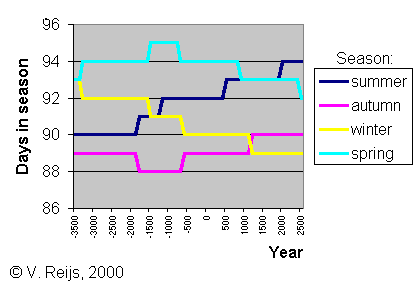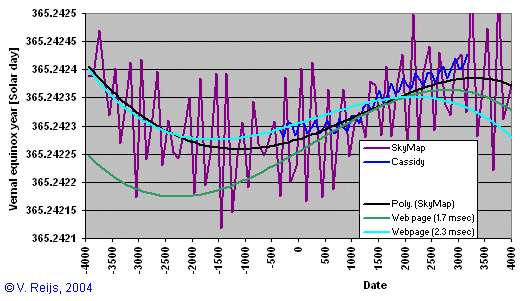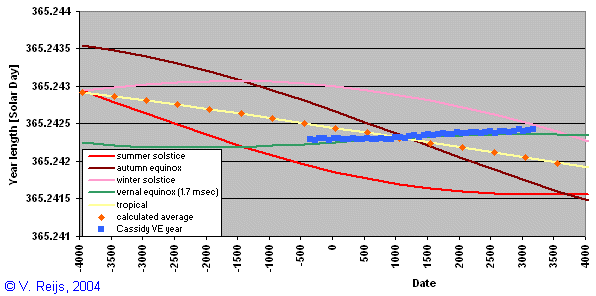 Home
Home Up
Up Search
Search Mail
Mail
NEW
The length of the astronomical seasons
The declination of the sun over the tropical year is determined by a
slightly adjusted formula of Ruggles [1999,
page 54] and Thom [1967, page
24]:
With:
n: number of Days after summer solstice day
np: the position of perihelion
seen from summer solstice in Days. I determined them using SkyMap Pro 9
(these values are different then in Ruggles [1999, page 54]):
Year
|
Perihelion (np)
[Days]
|
2000 CE
|
197.26
|
2000 BCE
|
126.04
|
4000 BCE
|
90.41 |
Tropicalyear: length of Tropical year
Anomalistyear: length of Anomalistic
year
Obliquity [°]
Ecccentricity [-]
The below figure provides insight in the length of the
astronomical seasons based on the above formula:

Following modern definitions of the astronomical seasons:
- Summer
From summer solstice (max. declination) until autumn equinox
(declination=0)
- Autumn
From autumn equinox (declination=0) until winter solstice (min.
declination)
- Winter
From winter solstice (min. declination) until spring equinox
(declination=0)
- Spring
From spring equinox (declination=0) until summer solstice (max.
declination)
Definition of equinox
A few definitions of equinox are possible over (pre-)history:
- the date when set and rise azimuths of sun (on one day) are
opposite (180º) to each other. No counting of days is
needed (is easy to determine). Will come close to modern
definition of equinox, if horizon altitude is the same for set
and rise positions.
- the date that the sun's rise (or set) azimuth is half way the
rise (or set) azimuths of winter and summer solstice (is quite
easy to determine). If the rise (or set) altitudes are the same
for solstices/equinoxes, this will provide an equinox date close
to the modern definition (although it does not account for the
variation due to Climatic precession
changes).
- the date that the sun is again at the same location after
182/183 days (is relatively easy to determine). Method used by
Thom ([1967], page 109). This will
have the 'equinox' declinations at around 0.5º
- the date half way the summer and winter solstices dates.
Remember half way the solstice dates is difficult to determine
due to slow movement of sun around these solstices (thus not
easy to determine).
- the date when the sun rises due east or sets due west. In this
case the concept of east/west must be known and to reach the
modern equinox definition the horizon altitude must be 0º.
- From DIO web-site:
"Equinoxes are not (and were
not anciently) determined “near sunrise and at sunset” as ...
asserts, and that cannot be true for the equinox of 132 AD,
which was allegedly observed at 2 PM. Ptolemy says his
equinoxes were determined by noon observations using a
‘meridian” transit instrument (Almagest 3.1’s
reference to I.12; Toomer p 61) which only can observe on the
meridian."
- the modern definition (declination = 0), will be quiet
unlikely for neolithic man, because the concept of the ecliptic
was not yet known (I think). But an indirect effect of
declination is a straight line shadow of a top of a pole (see
the horns of the solstices).
- The date a gnonom casts a straight
solar shadow on the plate.
- The date that the Full Moon and Sun swap
their rise (or set) place on the horizon (so when the Sun
first rises e.g. more northern than the Moon). This concept is
thought of by C. da Silva [2004], which in its turn is mentioned
by F. Silva (Equinoctial full
moon models and non-Gaussianity: Portuguese dolmens as a test
case, [2011])
and calls it 'Megalithic Equinox'. This is around a declination
of plus or minus 4 degrees.
Vernal equinox year
The Vernal equinox year length is slowly changing. In the below
picture one sees the Vernal equinox year in Solar days.
SkyMap Pro 9 (purple) values (see for
its theoretical backbone on this page)
are compared with computed (green)
values which are calculated
with above formula and with (dark blue) values
of Simon Cassidy. The SkyMap Vernal equinox year
is calculated as the average over 100 Vernal equinox years (the 4th
order polynoom (black) values are also provided based on values up
to 5000 CE).

The calculated
(green) values (with a change of 1.7
msec per century for Solar day, Stephenson [
1997, page 514]) are quite
close to SkyMap Pro 9's values (around 2 sec for the period 2500
CE to 400 BCE). This graph is quite different from the SkyMap
values when looking before 400 BCE.
Two things can be seen:
- If I take a change of 2.3 msec per century for Solar day,
the above results (light
blue curve) for former years gets closer to the
SkyMap results.
SkyMap Pro 10 (like Cassidy) uses Stephenson & Houlden
[1986] for DeltaT and n-dot of -26 ["/cy2], which
can explain the 2.3 msec per century. SkyMap Pro could be
changed in future (pers. comm. C. Mariott [2004]).
- The above sinusoidal function (green values) seen in the vernal-equinox
year seems to be somewhat out of phase and/or period. This
needs more investigation.
- As Cassidy says; the vernal-equinox
year (green line and blue squares) is quite stable over the present years
(while the other event years change more) and that is why he
thinks that vernal equinox could have been chosen as the
start of the year.
Looking at the below graph, winter-solstice (pink line) was
also quite stable around neolithic times, so could this have
been the start of the year in neolithic time... So I
doubt if Stonehenge was following the vernal-equinox start
of the year as discussed by Cassidy.
But to be honest, I don't know if neolithic man was
able to determine this temporal stableness of the mean
winter-solstice/vernal-equinox year without having accurate
clocks.
The vernal-equinox and winter-solstice years do not quite
follow the average event years of course (=mean tropical
year):
- The above formula has been checked with Meeus' formula,
using information from Irv
Bromberg [Pers.comms 2006]:
There is not much difference (max. 17 sec [1 sigma]) between
my formula and Meeus'. This difference is somewhat larger
then the normal variation
(5*60/100 = 3 sec) of a year.
Disclaimer and Copyright
 Home
Home Up
Up Search
Search Mail
Mail
Last major content related changes: May 20, 2004



